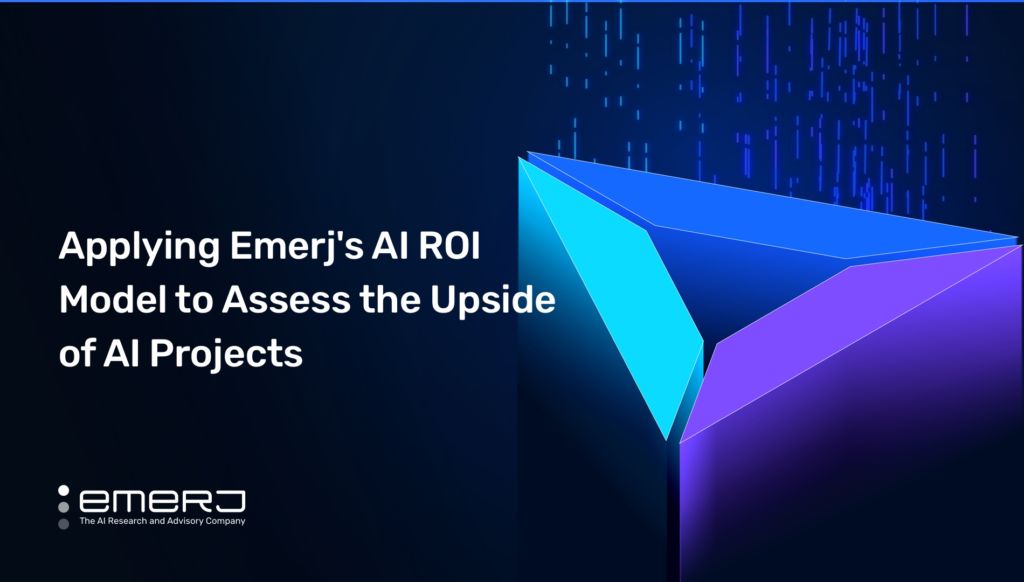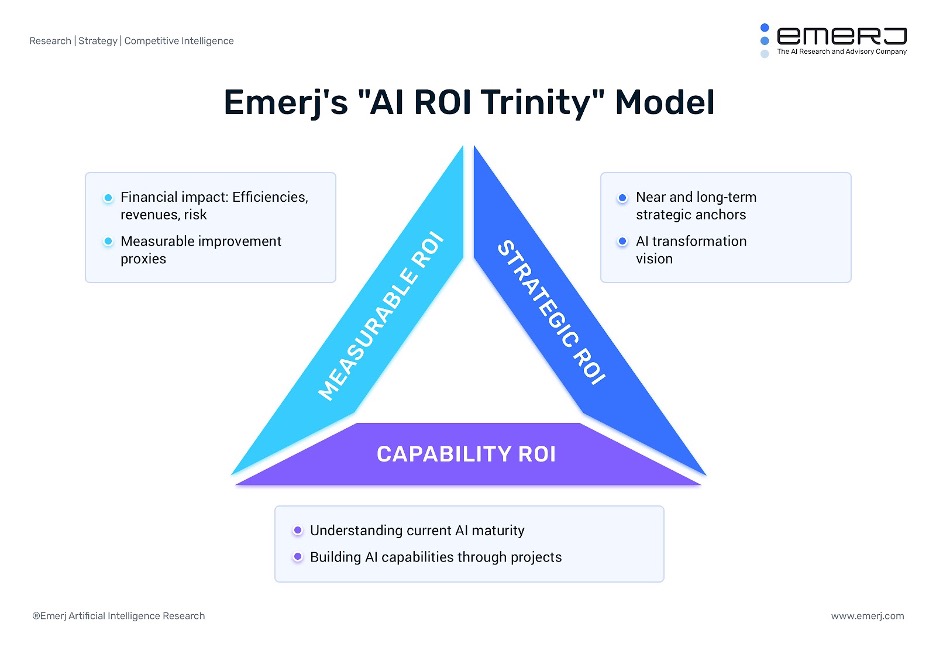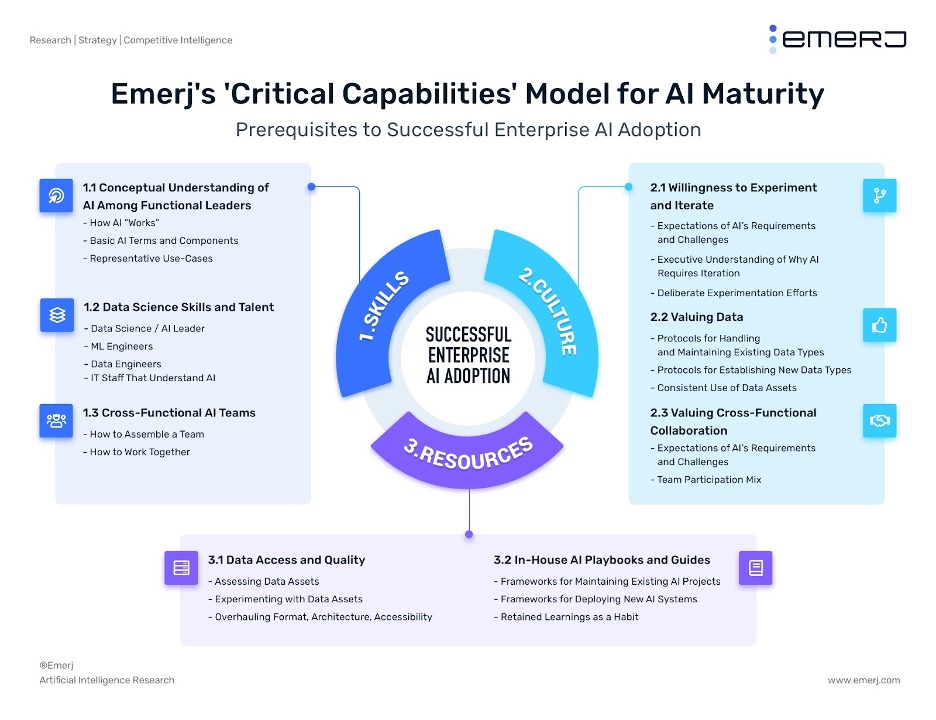
At Emerj, we calculate and convey the ROI of AI across three distinct ROI categories:
Measurable ROI refers to the quantifiable aspects of AI project impact – which could include financial measures (cost savings, revenue drivers) or non-financial (reduced manufacturing equipment temperatures, improved self-reported customer service scores).
Strategic ROI refers to the ability of AI to influence the long-term strategic goals of a company, such as 3-5 year goals, current thrusts or initiatives, digital transformation vision, etc.
Capability ROI refers to the impact of an AI project on a firm’s overall level of AI maturity – which includes the skills, resources, and culture required to deploy AI successfully.

Emerj’s AI ROI Trinity model. Source: (Emerj Plus) AI Best Practice Guides
Measurable ROI
With measurable ROI, we consider how a project will make or save us money or how it will potentially reduce risk. Risk reduction is the hardest to measure, but there are ways we can extrapolate it.
Remember that we can make money in a variety of ways. We can get more customers. We can make more money per each customer when they transact with us. We can reduce our churn rate and retain customers longer. And, by retaining them, we add more dollars to our coffers over their lifetime.
We can save money by saving time. We can reduce the number of hours we need to achieve a specific task. We can completely automate a task and reallocate humans to something more productive. We can save all that sunk cost and not involve people at all.
Tip: Find a Big Needle, and Move it a Little
When we’re brainstorming and thinking about measurable ROI, we can start by looking at the biggest line items in the business and find a way to impact those line items. So, if we want to make a powerful ROI case, we can start by chipping away 0.1% or 0.01% from some big line item. If we’re trying to save money, it’s a more powerful case if, when we can go to leadership and present our ROI case, we say, “Hey, the biggest expense that you have is x. And here’s how we can attack that expense.”
Let’s consider an example of a manufacturing company. The biggest line item or expense that they have is raw materials. In this case, we may ask: Through logistics and supply chain, through vendor negotiation, through optimizing pricing and sourcing, can we chip 0.1% or 0.01% from that line item? How many millions of dollars would that be worth to the business?
Often, there’s a plausibility reasoning here, where if we can take whatever project we’re working on and tie it to the thing that is draining the coffers the most—if we can make that connection, then it often behooves us to make it.
We have to find a way to quantify the benefits that AI will bring, whether that’s making and saving money, and/or potentially reducing risk too—regulatory risk, bad press risk, risk of a catastrophic failure of our manufacturing equipment.
The key is to come up with as many measurable ROI ideas as possible. Then, we want to think about all the ways we might measure how a project could make or save money or reduce risk.
We need input from both data scientists and subject matter experts. Then for each project, we want to think about the small handful of measurable ROI benchmarks that we’re going to use. It’s rarely going to be the first thing that comes to mind.
There’s almost always something better than that—and we want to determine what that is.
Strategic ROI
In strategic ROI, we think about how artificial intelligence fits into the company’s strategic goals. For example, we might have a five-year goal of being the number two competitor for market share for a kind of baby food. Or we might have the current thrust behind an initiative to tighten up our cyber security.
We might have a key differentiator of having better customer service and a better customer experience online than any of our competitors, whatever the case may be.
Any of these can serve as a potential strategic anchor. The question is, how do we take our projects, put them through these filters and figure out which ones are relevant to this AI project. We might be working on a project that doesn’t have anything to do with cybersecurity, for example. In this case, we’re not going to tie it to that strategic anchor.
We want to look at its relevance to initiatives. Ask:
- What are the strategic anchors?
- What are the client’s strategic goals that align with this project?
- Which of their high-level strategic anchors tie to this project?
Then we ask: Which projects are relevant? Which project does leadership care the most about?
Once we ask which project matters most to leadership, we’ll develop a very short list of potential strategic value points for this AI project that we’re going to use when we get into the presentation phase.
Capability ROI
Capability ROI is about building capabilities to enable future AI innovation and to unlock the value of data.
The majority of buying stakeholders think of AI like any other IT solution. It needs to be plugged in – and then it needs to deliver its results. AI requires an entirely new way of working with data and teams, an understanding of AI use-cases and applications, and cultural changes in a firm’s willingness to experiment and iterate.
In the words of Silicon Valley AI consultant Dr. Charles Martin, “AI is not IT.”
In my speaking engagements with corporate clients, I often say it this way:
“Every AI project should not only be guiding a firm towards near-term measurable ROI, and towards a long-term strategic outcome, every AI project should be an investment in a company’s ability to leverage AI to win in the market.
Any AI project that does not build AI maturity is a failure.”
Clients often don’t understand this at all. Most clients are focused on near-term Measurable ROI with little to no concern about the other two factors. For this reason, internal AI champions or outside AI consultants must educate their buying stakeholders, and present AI maturity (i.e., re-training team members, overhauling or altering data infrastructure, building a culture of iteration, etc.) as a benefit in addition to a cost.
No AI initiative will be a magic bullet, a market-winning single capability. Many projects will fail – but firms who succeed and leverage AI nimbly into the future are those who will reap its benefits.
Below is our Critical Capabilities model for AI maturity. Consider these factors when presenting Capability ROI to leadership.
(Note that these factors are for functional business leaders, and not for IT or data science leaders. Their prerequisites to successful AI deployment would be significantly more technical, and less focused on team alignment and culture, which is usually the job of functional business leaders and executives.)

Emerj’s Critical Capabilities AI maturity model. Source: (Emerj Plus) Prerequisites to Successful AI Adoption
Conveying capability ROI requires education and a catalyst, and it needs to be a component of business transformation projects.
Capability ROI allows a client to understand a project’s value. Beyond the near-term return on investment, capability ROI also makes clear that we’re building core skills for the future. That’s why capability ROI forms the foundation of our three-pronged ROI model.
If we know that our project will help build data access and quality across a department, improve the willingness of a company to experiment and iterate, we will have to educate a lot of leadership and subject matter experts about AI.
Whichever critical capability we’re building, we want to be able to explain it to the client, generally speaking, in terms of measurable and strategic ROI. Consider:
“Hey, Mr. Buyer, we’re going to provide better data access and quality, and that’s going to allow us to X, provide a measurable return on investment, and save money. It’s also going to allow us to do Y, continue to improve our user experience to be better than that of our competitors, and stay ahead of the pack.”
We need to make logical, straightforward connections, not wishy-washy connections. We need to connect how the capabilities we will build are important for the long term, but also tie immediately to measurable and strategic ROI.
We need to have this clear before we present our business case and know the maturity that these projects are going to build. Any transformation within an enterprise that ignores maturity as a factor of ROI is just misguided. That’s a core part of our message at Emerj.



